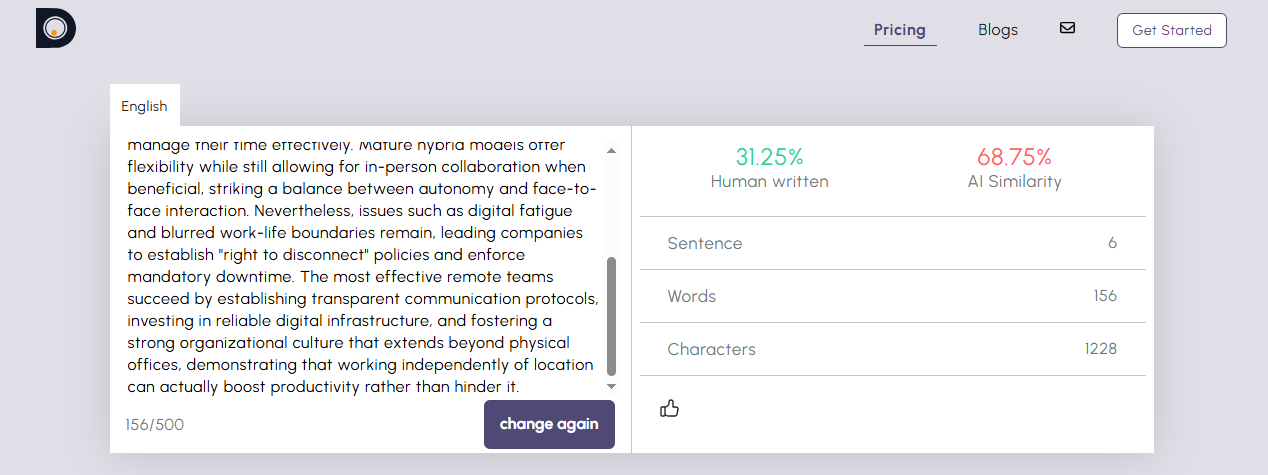Rewording Tool vs Undetectable AI Rewriter: Which Tool Removes AI Detection More Effectively?
Compare Rewording Tool and Undetectable AI Rewriter to see which one better removes AI detection and makes your content read naturally.
AI writing tools are not just for speeding up your content creation. There are many other things AI does for us in 2025. Like ideation, drafting, optimization, and humanizing.
In fact, according to Siege Media, around 90% of content marketers are expected to use AI tools by the end of this year.
Using AI is fine, but getting rid of its detectable signature is the real challenge. Platforms like Google and even readers can detect it.
That’s why I compared the Rewording Tool against the Undetectable AI Rewriter. To see which one hides AI traces more effectively.
In my testing, I focused on clarity, human-likeness, and, most importantly, how well each tool fools modern AI detectors. One tool stood out — and it wasn’t who I expected.
The core difference: humanized rewriting vs AI signature masking
Before I start comparing the tools, it’s important to understand one thing. Both claim to “remove AI detection,” but they’re built for two very different goals.
Rewording tool focuses on humanized rewriting.
Its goal is to take AI text and understand its context through Natural Language Processing (NLP). Then recreate it from scratch. So it flows naturally, sounds conversational, and reads like a real person.
Basically, it is trained to mimic humans in writing.
Its primary aim is to manipulate AI patterns that detectors catch. Like predictability, sentence uniformity, and repetition. So it does not care about sentence quality.
In simple terms:
- Rewording Tool = focuses on how humans write
- Undetectable AI = focuses on how detectors score
Both remove AI detection, but they take two completely different methods.
Hands-on test #1: Undetectable AI rewriter in action
To see how Undetectable AI actually performs, I tested it with a 120-word paragraph. I wrote with Claude AI about “remote work productivity in 2025.”
Then I ran it on its rewording tool. Here’s what I found:
It’s good at rewriting
The tool doesn’t just adjust wording. It restructures entire sentences. Sometimes it feels like a brand-new paragraph.
Strong at masking AI patterns
The results clearly sounded less robotic. Even had more phrasing variety and more natural words.
Makes your tone more casual
Almost every rewrite came out more casual and conversational. Even if the original text was neutral.
That was good! But I also witnessed a few issues:
- It felt like a few sentences were out of context. Not ideal for factual or technical content.
- It even added filler words that weren’t in the original text. Those are not good for professional writing.
- Some sentences were inconsistent with the tone as well. So if you need a professional tone, you may have to manually adjust it.
Still, the promise is undetectable AI, which we need to check. Even if precision takes a small hit.
Hands-on test #2: Rewording-tool.com in action
To compare fairly, I used the exact same AI-generated paragraph again. I ran it through the Rewording tool’s “humanize” mode.
And I found this:
Sentence flow was much more natural
The result sounded like an actual human talking. Transitions were smooth, a few robotic phrases, and a clear voice.
It had a better variety in sentence structures
Unlike Undetectable AI, the Rewording tool didn’t just swap words. It rebuilt sentences from scratch. It removed all the awkward repetitions and added transitions.
Offers multiple tones + extra flexibility
I tested many modes that it offers, like casual, professional, fluent, etc. All three produced noticeably different styles. So it’s not just surface-level changes.
This is extremely useful for multichannel marketing. Like blogs, emails, and social media posts.
It kept the meaning intact
The original message was the same in the end.
No exaggerations, no unnecessary hedging. Just a cleaner version of the same point.
Overall: AI rewording tool didn’t just “hide the AI signature.” It actually improved the writing. That’s stronger than Undetectable AI.
Feature comparison: what each tool is actually built for
Before I compare results, it’s important to understand what each tool is designed for. Their goals aren’t the same. And that affects performance.
Undetectable AI is built to bypass AI detectors
There is only one purpose of this tool: to remove AI fingerprints.
Everything inside the tool is trained to fool AI detectors.
Key features of this tool are:
- It prioritizes AI masking over clarity
- Often rewrites heavily. Even when the meaning doesn’t need to change
- Focuses more on AI pattern shifting than true human-like flow
- Sometimes it introduces extra complexity. Because detectors associate complexity with human writing
It works, but you can feel that “over-processed” tone, even after using its rewriting tool.
Rewording tool is for human-like rewriting
Rewording tool isn’t built to bypass AI detection. Its core design is to make it human.
And if you achieve that, AI detectors are automatically bypassed.
Key traits of this tool are:
- It rewrites based on the tone and the modes you select. Even words are selected accordingly.
- It is really good at keeping the meaning intact.
- Creates cleaner, more organic sentence delivery.
- Includes first person, humanized, casual, creative, professional, and multilingual modes.
It doesn’t “force” complexity. It uses the natural ability to rewrite text in a better version.
What this means for users
- If you want AI removed from the content, then Undetectable AI’s rewriting tool is good.
- If you want balanced and natural rewriting like the human editors do, then the Rewording tool is best for this.
AI detection tests
In this section, I will share the exact results I found after using both tools.
To keep this comparison fair, I used the same 120-word AI-generated paragraph (written using Claude AI).
Then I ran the rewritten outputs from both tools through AI-detector.info—a well-known detector frequently used in academic and publishing circles.
Here’s what happened:
Undetectable AI rewriter results
- The output did reduce the AI probability score.
- But it still showed some chances of AI involvement.
- The tool mainly changed sentence structure and swapped synonyms. This fooled the detector a bit. But not fully.
- The tone sometimes felt overly “neutral.”

Rewording tool results
- The rewritten text scored very low on AI involvement.
- It changed sentence flow more aggressively. The writing felt closer to natural human rhythm.
- The variation it added in sentence lengths and the natural phrasing made it harder for the detector to detect.

Winner in detection tests: Rewording tool
I’ve shared only one result, but I did many attempts. It consistently produced text that was more human and less AI. What we were looking for.
Sentence naturalness comparison
As we know only bypassing AI detectors is not enough. So I wanted to check which tool produces more human-sounding sentences. Not just undetectable text.
I ran both outputs through ProWritingAid’s editor. And here’s what I got:
Undetectable AI’s output
- Some sentences were still mechanical
The tool removes AI patterns well. But sometimes the rhythm feels flat. As if every sentence was optimized the same way. That’s why the style score was only 67%.
- Sentence variety is limited
ProWritingAid flagged several lines for “Repetitive Sentence Starts” and “Unnatural Flow.” Even the sentence length was too much (22).
- Low readability
It’s clean and clear. But not to everyone. ProWritingAid found that only graduates can read and understand it easily.
Rewording tool output
- More natural sentence structuring
ProWritingAid detected higher “Sentence Variety.” It was a mix of short, medium, and long structures that is similar to real human writing.
- Better readability
Transitions were more human, not auto-generated. And the word choice was conversational. That’s why the readability was at “Grade 8.”
- Fewer style alerts
The style score was at 82%, which is pretty good for me. It triggered only a few warnings.
Result:
According to ProWritingAid’s analysis, the Rewording Tool produced more natural, varied, and human-like sentences overall, even before running anything through AI detectors.
My verdict
After performing all these tests, the results were clear:
Rewording tool is overall good in humanizing AI generated content. Its results are more natural across different paragraph writing styles.
Undetectable AI’s rewriting tool is good at reducing AI signals, and tends to over-simplify sentences. It sometimes makes the text feel “flattened” or slightly generic.
If your goal is balanced rewriting that feels human, the Rewording tool is considered better based on every test we applied.




